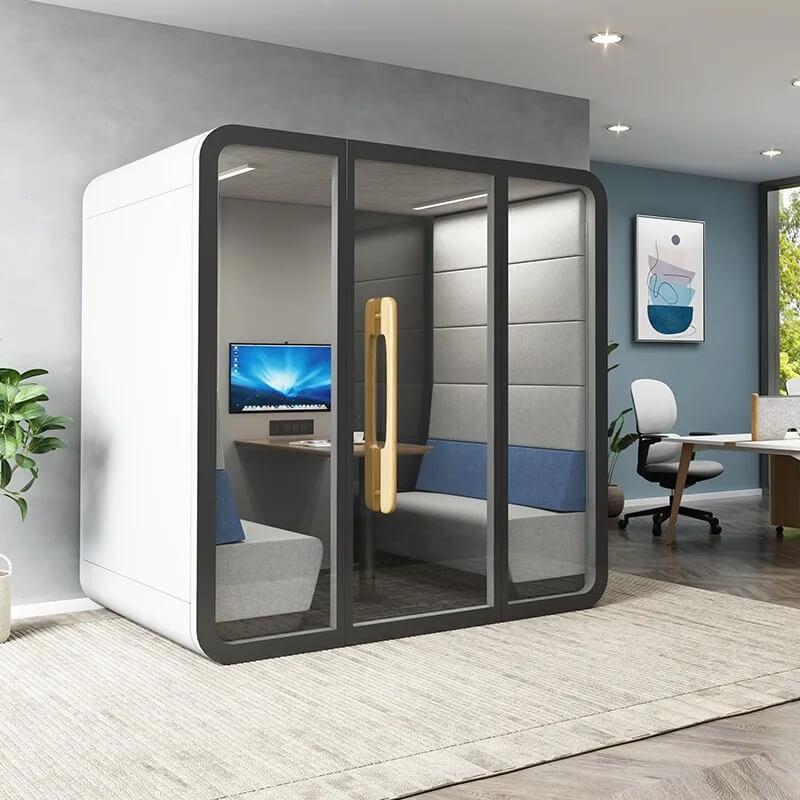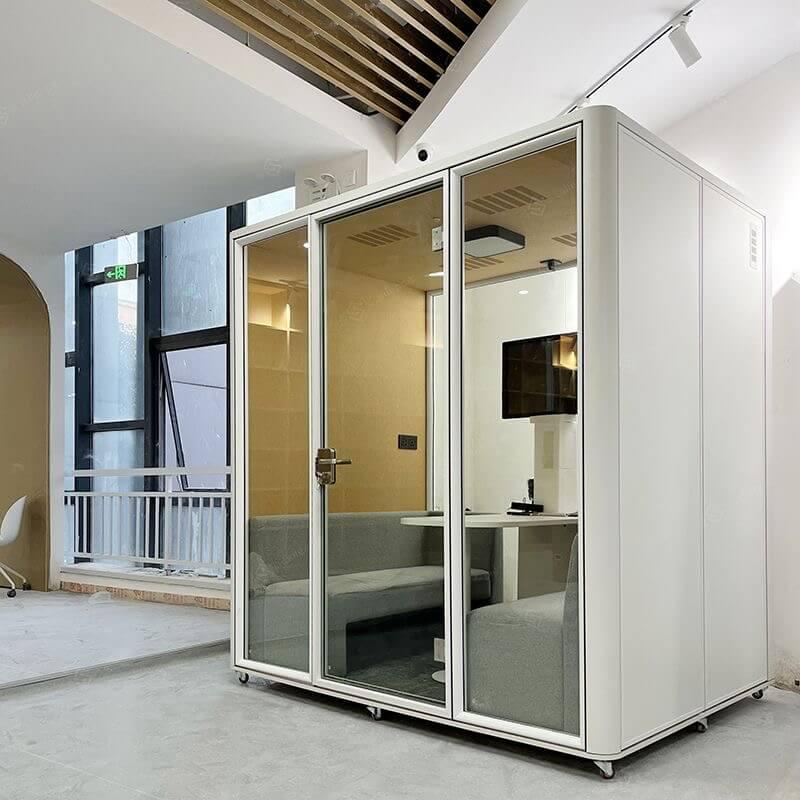Author:SOP Work Pods Manufacturer TIME:2025-02-26
In recent years, meeting booth pods have become essential tools in offices, coworking spaces, and other environments that prioritize privacy and focus. These soundproof pods offer a dedicated space for meetings, phone calls, or individual work without distractions. However, an often overlooked concern with these pods is ventilation. In this article, we’ll explore why proper ventilation in meeting booth pods is critical, how ventilation systems work, and how to maintain an optimal air quality for better health and productivity.

In any enclosed space, good ventilation is essential to maintain a comfortable and healthy environment. Without it, the air inside meeting booth pods can become stale and unpleasant. This can lead to discomfort, fatigue, and reduced cognitive function.
When ventilation is inadequate, users may experience symptoms like dizziness, headaches, or a general feeling of sluggishness. The build-up of CO2 in an airtight environment can create a stuffy atmosphere, making it hard for users to concentrate or stay alert.
Studies have shown that poor air quality can impair decision-making, focus, and overall performance. In meeting booth pods, where users may be confined for extended periods, these negative effects can be particularly pronounced. Ensuring proper ventilation helps users maintain sharpness and stay engaged during meetings or work sessions.
Most modern meeting booth pods incorporate ventilation systems designed to provide a continuous flow of fresh air. The type of system varies based on the pod’s design and purpose.
Some meeting booth pods rely on passive ventilation, using strategically placed vents to allow natural airflow. These vents can be positioned on the walls, ceiling, or floor of the pod. While passive systems can be effective in certain environments, their performance can be impacted by external air quality and weather conditions.
Other pods incorporate active ventilation systems, which rely on fans or air circulation units to continuously draw in fresh air and expel stale air. These systems provide a more controlled airflow and are often quieter than larger HVAC systems, ensuring that the user’s concentration is not disturbed.

While many meeting booth pods come with built-in ventilation, several challenges can arise when it comes to ensuring proper airflow.
Soundproofing is a priority for most meeting booth pods, but sometimes this can lead to overly tight seals that restrict airflow. In these cases, even if the pod has ventilation systems, the lack of external airflow can result in a buildup of CO2 and stale air.
Pods designed for larger groups may struggle with ventilation if the number of users exceeds the system’s capacity. The ventilation needs of a larger group can quickly overwhelm the pod’s air circulation, leading to discomfort and poor air quality.
Dust and debris can clog vents or filters, reducing airflow and making the ventilation system less effective. Regular cleaning and maintenance are crucial to ensure the system functions properly and keeps the air fresh.
There are several steps that can be taken to ensure proper ventilation in meeting booth pods, which will improve both comfort and productivity.
When selecting a meeting booth pod, look for models that feature adjustable active ventilation systems. These systems, often equipped with small fans or air circulators, allow users to control the airflow and ensure they’re comfortable for long periods of use.
Keeping the meeting booth pod clean is essential for maintaining good air quality. Regularly cleaning the vents and replacing filters is necessary to ensure airflow remains optimal and free of obstructions.
Even the best ventilation systems can struggle if the surrounding environment has poor air quality. When choosing a location for meeting booth pods, prioritize spaces with good air circulation and avoid areas with high levels of pollution or excessive humidity.
If possible, choose meeting booth pods that can be connected to the building’s existing HVAC system. This connection can enhance the overall air quality in the pod, ensuring a fresh and breathable atmosphere throughout the day.
Ensuring meeting booth pods are well-ventilated not only enhances comfort but also promotes better health and productivity.
Long-term exposure to poor air quality can result in respiratory issues or exacerbate pre-existing conditions like asthma or allergies. Proper ventilation reduces these risks, creating a healthier environment for users.
Good airflow helps prevent the mental fatigue caused by elevated CO2 levels. By ensuring the air is fresh and breathable, users are able to focus better and think more clearly, which is essential during important meetings or collaborative work.

In conclusion, meeting booth pods are an excellent solution for ensuring privacy and concentration in busy office settings. However, to function optimally, these pods must also be equipped with proper ventilation systems. Whether through passive or active solutions, adequate airflow is essential for maintaining a comfortable, healthy, and productive environment.
By considering ventilation features when selecting or designing meeting booth pods, and implementing a routine maintenance schedule, businesses can create an optimal workspace that supports both the physical and mental well-being of their users.
Ventilation in meeting booth pods is often an afterthought, but it plays a pivotal role in the success of these spaces. By investing in quality ventilation and regularly maintaining it, users can enjoy the privacy and concentration they need without sacrificing comfort or productivity.